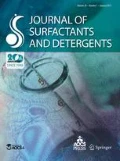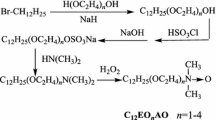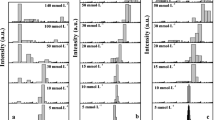Abstract
The hydrophobicity of alkyl-polypropylene oxide sulfate surfactants was evaluated via their characteristic curvature (Cc) using the hydrophilic-lipophilic difference (HLD) framework. A close examination of the relationship between the molecular structure of the surfactants considered (structure of the alkyl group and the number of propylene oxide groups in each surfactant) and their Cc led to a group contribution model that, for the first time, takes into consideration the geometry of the alkyl tail group. Based on this group contribution model, branching at the C2 (beta-carbon) position of the alkyl group produces the largest increase in characteristic curvature. This observation is consistent with the notion that the Cc is associated with the packing factor for anionic surfactants. Branching at the C2 position tends to produce cylindrical or inverse cone shape packing, typical of more hydrophobic (positive Cc) surfactants. This study also confirms previous observations that, different from conventional anionic surfactants, the phase behavior of alkyl polypropylene oxide sulfates is less sensitive to electrolyte concentration and that these formulations turn hydrophobic with increasing temperature, akin to the behavior of nonionic surfactants.








Similar content being viewed by others
References
Watcharasing S, Kongkowit W, Chavadej S (2009) Motor oil removal from water by continuous froth flotation using extended surfactant: effects of air bubble parameters and surfactant concentration. Sep Purif Technol 70:179–189
Kaewpukpa R, Chavadej S, Scamehorn JF (2008) Oily soil detergency under microemulsion conditions: effects of oil loading and surfactant adsorption. Adv Mater Res 55–57:929–932
Witthayapanyanon A, Acosta EJ, Harwell JH, Sabatini DA (2006) Formulation of ultralow interfacial tension systems using extended surfactants. J Surf Deterg 9:331–339
Childs J, Acosta E, Scamehorn JF, Sabatini DA (2005) Surfactant-enhanced treatment of oil-based drill cuttings. J Energy Res Technol 127:153–162
Quintero L, Clark DE, Jones Th, Salager JL, Forgiarini A (2008) In situ fluid formation for cleaning oil- or synthetic-oil-based mud. US patent application 20080110618. Baker Hughes Inc., Assignee
Adams WT, Schievelbein VH (1987) Surfactant flooding carbonate reservoirs. SPERE 2:619–626
Maerker JM, Gale WW (1992) Surfactant flood process design for Loudon. SPERE 7:36–44
Wu WJ, Vaskas A, Delshad M, Pope GA, Sepehrnoori K (1996) Design and optimization of low-cost chemical flooding. In: Proceedings SPE/DOE 35355, symposium on improved oil recovery, Tulsa, OK, 21–24 April
Aoudia M, Wade WH, Weerasooriya V (1995) Optimum microemulsions formulated with propoxylated guerbet alcohol and propoxylated tridecyl alcohol sodium sulfates. J Disp Sci Technol 16:115–135
Miñana-Pérez M, Graciaa A, Lachaise J, Salager JL (1995) Solubilization of polar oils in microemulsions system. Colloid Polym Sci 98:177–179
Huang L, Lips A, Co CC (2004) Microemulsification of triglyceride sebum and the role of interfacial structure on bicontinuous phase behavior. Langmuir 20:3559–3563
Scorzza C, Godé P, Goethals G, Martin P, Miñana-Pérez M, Salager JL, Usubillaga A, Villa P (2002) Another new family of “extended” glucidoamphiphiles. Synthesis and surfactant properties for different sugar head groups and spacer arm lengths. J Surf Deterg 5:337–343
Fernández A, Scorzza C, Usubillaga A, Salager JL (2005) Synthesis of new extended surfactants containing a xylitol polar group. J Surf Deterg 8:193–198
Fernández A, Scorzza C, Usubillaga A, Salager JL (2005) Synthesis of new extended surfactants containing a carboxylate or sulfate polar group. J Surf Deterg 8:187–191
Phan TP, Witthayapanyanon A, Harwell JH, Sabatini DA (2010) Microemulsion-based vegetable oil detergency using an extended surfactant. J Surf Deterg 13:313–319
Wittayapanyanon A, Phan TP, Heitmann TC, Harwell JH, Sabatini DA (2010) Interfacial properties of extended-surfactant-based microemulsions and related systems. J Surf Deterg 13:127–134
Do L, Wittayapanyanon A, Harwell JH, Sabatini DA (2009) Environmentally friendly vegetable oil microemulsions using extended surfactants and linkers. J Surf Deterg 12:91–99
Forgiarini AM, Scorzza C, Velásquez J, Vejar F, Zambrano E, Salager J-L (2010) Influence of the mixed propoxy/ethoxy spacer arrangement order and of the ionic head group nature on the adsorption and aggregation of extended surfactants. J Surf Deterg 13:451–458
Velasquez J, Scorzza C, Vejar F, Forgiarini AM, Anton RE, Salager JL (2010) Effect of temperature and other variables on the optimum formulation of anionic extended surfactant-alkane-brine systems. J Surf Deterg 13:69–73
Witthayapanyanon A, Harwell JH, Sabatini DA (2008) Hydrophilic-lipophilic deviation (HLD) method for characterizing conventional and extended surfactants. J Colloid Interface Sci 325:259–266
Bancroft WD (1913) The theory of emulsification V. J Phys Chem 17:501–519
Bancroft WD (1915) The theory of emulsification VI. J Phys Chem 19:275–309
Griffin WC (1949) Classification of surface active agents by HLB. J Soc Cosmet Chem 1:311–326
Davies JT (1957) A quantitative kinetic theory the emulsion type. I. Physical chemistry of the emulsifying agent, in gas/liquid and liquid/liquid interfaces. In: Proceedings of the second international congress on surface activity, Butterworths, London, vol 1, p 426
Winsor PA (1954) Solvent properties of amphiphylic compounds. Butterworths, London
Shinoda K, Saito H (1968) The Effect of temperature on the phase equilibria and the types of dispersions of the ternary system composed of water cyclohexane, and nonionic surfactant. J Colloid Interface Sci 26:70–74
Shinoda K, Arai H (1964) The correlation between phase inversion temperature in emulsion and cloud point in solution of nonionic emulsifier. J Phys Chem 68:3485–3490
Kabalnov A, Wennerström H (1996) Microemulsion stability: the oriented wedge theory revisited. Langmuir 12:276–292
Roger K, Cabane B, Olsson U (2010) Formation of 10–100 nm size-controlled emulsions through a sub-PIT cycle. Langmuir 26:3860–3867
Davis HT (1994) Factors determining emulsion type: hydrophile-lipophile balance and beyond. Colloids Surf A 91(C):9–24
Bourrel M, Salager JL, Schechter RS, Wade WH (1980) A correlation for phase behavior of nonionic surfactants. J Colloid Interface Sci 75:451–461
Salager JL, Morgan JC, Schechter RS, Wade WH, Vasquez E (1979) Optimum formulation of surfactant/water/oil systems for minimum interfacial tension or phase behavior. Soc Pet Eng AIME J 19:107–115
Salager JL, Marquez N, Graciaa A, Lachaise J (2000) Partitioning of ethoxylated octylphenol surfactants in microemulsion-oil-water systems: influence of temperature and relation between partitioning coefficient and physical chemical formulation. Langmuir 16:5534–5539
Acosta EJ, JSh Yuan, Bhakta A (2008) The characteristic curvature of ionic surfactants. J Surf Deterg 11:145–158
Salager JL (1996) Quantifying the concept of physico-chemical formulation in surfactant-oil-water systems-state of the art. Prog Colloid Polym Sci 100:137–142
Israelachvili JN (1987) Physical principles of surfactant self-association into micelles, bilayers, vesicles and microemulsion droplets. In: Mittal KL (ed) Surfactants in solution: recent developments, vol 4. Plenum, New York, pp 3–34
Kunz W, Testard F, Zemb T (2009) Correspondence between curvature, packing, and hydrophilic-lipophilic deviation scales around the phase inversion temperature. Langmuir 25:112–115
Acosta E, Szekeres E, Sabatini DA, Harwell JH (2003) Net average curvature model for solubilization and supersolubilization in surfactant microemulsions. Langmuir 19:186–195
Acosta EJ, Bhakta AS (2009) The HLD-NAC model for mixtures of ionic and nonionic surfactants. J Surf Deterg 12:7–19
Kiran SK, Acosta EJ (2010) Predicting the morphology and viscosity of microemulsions using the HLD-NAC model. Ind Eng Chem Res 49:3424–3432
Acosta EJ, Szekeres E, Harwell JH, Grady BP, Sabatini DA (2009) Morphology of ionic microemulsions: comparison of SANS studies and the net-average curvature (NAC) model. Soft Matter 5:551–561
Salager JL (1999) Ionic microemulsions. In: Kumar P, Mittal KL (eds) Handbook of microemulsion science and technology. Marcel Dekker, New York, pp 247–280
Salager JL, Anton R, Anderez J, Aubry JM (2001) Formulation des microémulsions par la méthode HLD. Techniques de l’Ingenieur, Génie des Procédés J2 157:1
Phan TT, Harwell JH, Sabatini DA (2010) Effects of triglyceride molecular structure on optimum formulation of surfactant-oil-water systems. J Surf Deterg 13:189–194
Nace VM (ed) (1996) Surfactant science series vol 60, “Nonionic surfactants polyoxyalkylene block copolymers. Marcel Dekker, New York
Schlossman M, Tikhonov AM (2008) Molecular ordering and phase behavior of surfactants at water-oil interfaces as probed by X-ray surface scattering. Annual Rev Phys Chem 59:153–177
Acknowledgments
The authors thank Geoff Russell for sulfating the materials, Nomihla Valashiya-Mdleleni for assistance with the phase boundary studies and Herbert Perkins and Nunzio Andriollo for analytical data.
Author information
Authors and Affiliations
Corresponding authors
About this article
Cite this article
Hammond, C.E., Acosta, E.J. On the Characteristic Curvature of Alkyl-Polypropylene Oxide Sulfate Extended Surfactants. J Surfact Deterg 15, 157–165 (2012). https://doi.org/10.1007/s11743-011-1303-2
Received:
Accepted:
Published:
Issue Date:
DOI: https://doi.org/10.1007/s11743-011-1303-2




